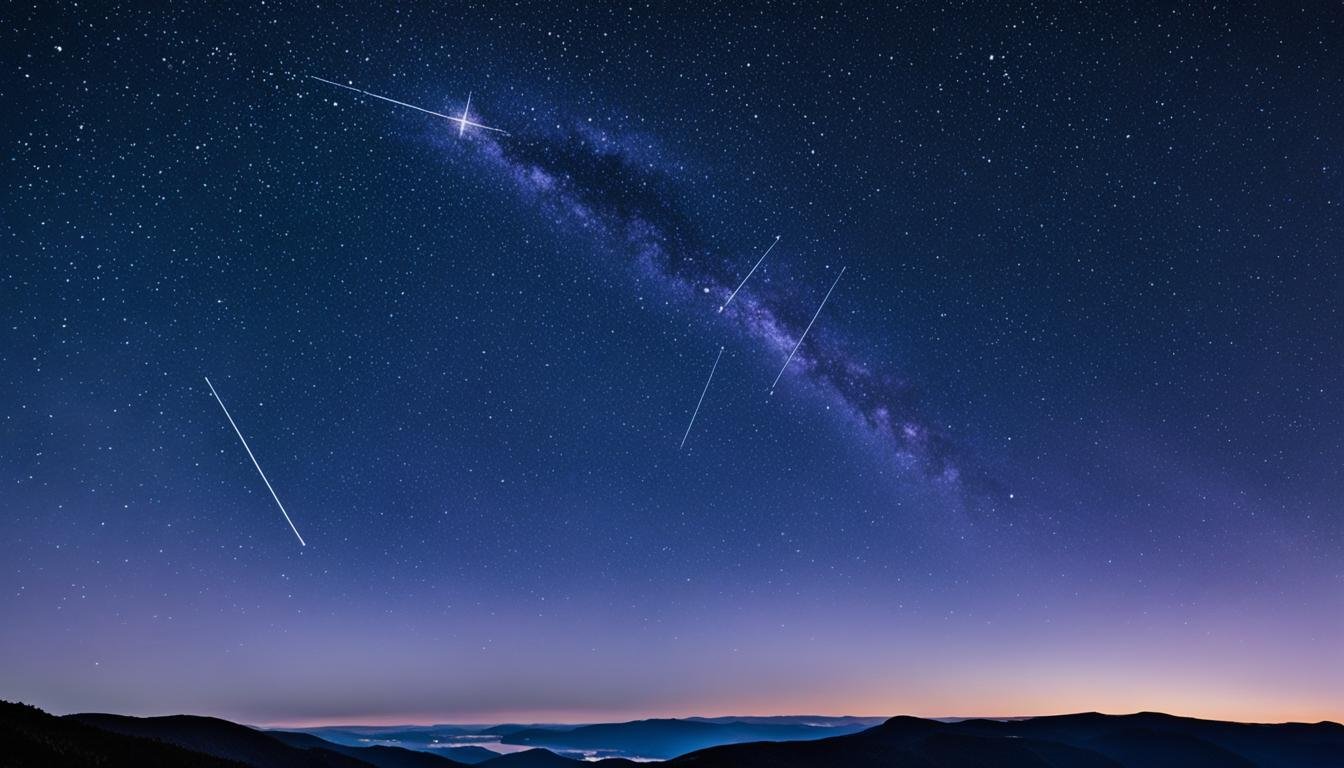Embark on a journey to uncover the splendors of the night sky with the Northern Cross asterism, a captivating star pattern that beckons astronomy enthusiasts and novice stargazers alike. Your celestial guide awaits amidst the stars of Cygnus, inviting you to traverse the ethereal pathways and gaze upon the cosmic marvels overhead. The Northern Cross asterism, a beacon in the dark, unlocks the fundamentals of astronomy basics with its distinguished shape and its role within the galactic panorama. Whether it’s a clear summer night or a serendipitous evening when the sky parts to reveal its majesty, a celestial spectacle unfolds for your night sky exploration delight.
Key Takeaways
- Identify the Northern Cross asterism in the constellation Cygnus as your starting point for night sky discovery.
- Explore the celestial navigation significance of the pattern, which has directed seekers of the skies for centuries.
- Learn about the intricate details and origins of this intriguing star formation integral to astronomy education.
- Enhance your stargazing experience by recognizing the role of the Northern Cross in tracking seasonal changes.
- Recognize the Northern Cross as part of the larger Summer Triangle, an impressive asterism in its own right.
- Embrace the Northern Cross as a celestial guidepost, leading the way to numerous deep-sky wonders.
Unveiling the Northern Cross Asterism: A Stargazer’s Delight
As you venture into the realm of stargazing, the Northern Cross asterism emerges as a celestial hallmark within the constellation Cygnus. This beacon in the sky is visible even when urban light pollution dims the stars. Part of its charm is its association with the Summer Triangle, a larger asterism that dominates the summer skies and aids in celestial navigation.
To locate the Northern Cross, begin your search with the star Deneb, its most luminous member. As part of your celestial journey, this star will lead you to discover Albireo at the base and the trio of stars which comprise the cross’s arm. Together, they form a pattern that is not just visually captivating but functionally significant, acting as a guide through the cosmic landscape.
| Element of Northern Cross | Description | Function |
|---|---|---|
| Deneb | Brightest star, tail of Cygnus | Marker for celestial orientation |
| Albireo | Base star, head of Cygnus | Visual anchor of the asterism |
| Crossbar Stars | Three stars forming the crossbar | Navigational guidepost |
Aside from its aesthetic allure, the Northern Cross serves as a structure upon which the Milky Way appears to be suspended, creating a stellar backbone that punctuates the galaxy’s ethereal glow. By using binoculars or a small telescope, you can transform this asterism into a portal, offering a glimpse into an abundance of stars and deep space sights embedded along the Milky Way.
This asterism’s importance extends beyond mere observation; it is a celestial compass that guides you across the sprawling celestial tapestry that unfolds on clear northern hemisphere summer nights. The following exploration of the Northern Cross will surely enhance your appreciation for this spectacular formation.
The Stars of the Northern Cross
As you gaze up at the night sky, you’ll find the Cygnus constellation cradling the famed Northern Cross asterism. This star formation is not only a beacon for navigating the cosmos but also a treasure trove of stellar tales and cosmic beauty. Bedazzled by an array of brilliant stars, each one contributes to the spectacular vista overhead.
Deneb: The Luminous Beacon
Deneb stands as the pulsating heart of the Northern Cross, a remarkable blue-white supergiant known as Alpha Cygni. Its searing light makes it a prominent cornerstone of the Northern Cross asterism and the Summer Triangle. With a luminosity that’s truly out of this world, Deneb is poised for a future supernova, a final cosmic performance you won’t want to miss.
Sadr: Heart of the Swan
Second in brightness and nestled in the center of the Northern Cross is Sadr, a yellow-white supergiant whose radiant energy envelopes the Cygnus constellation. At magnitude 2.23, Sadr’s steady glow serves as a guiding star, leading your eyes through the asterism’s celestial journey.
Aljanah and Fawaris: Wings in the Sky
To the sides, Aljanah and Fawaris shimmer as the extended wings of the swan, an orange giant and a sprightly triple star system respectively. Aljanah, also known as Epsilon Cygni, exudes a warm glow that complements the rapid spin of the blue-white giant within Fawaris.
Albireo: A Double Star Spectacle
At the base of the cross, Albireo dazzles stargazers with its dual star mystery, a showcase that is as elusive as it is enchanting. This binary system, consisting of a bright giant and its smaller companion, is an integral part of the Northern Cross asterism, making Cygnus constellation a must-see for avid observers of the cosmos.
Navigating the Night Sky Using the Northern Cross Asterism
If you’ve ever gazed up into the night sky and felt lost in its immensity, the Northern Cross asterism serves as the perfect starting point for your celestial journey. This notable pattern within the constellation Cygnus acts as a beacon not only for stargazers but for those exploring the ancient art of celestial navigation. With its significant position, identifying the Northern Cross is the first step in a voyage that extends across the star chart, deepening your connection with the constellations that have guided humanity for millennia.

Locating the Northern Cross
Embark on your stargazing adventure by seeking out Deneb, an illustrious point of light that anchors the Northern Cross. From there, sweep your gaze through the night sky to uncover Albireo at the base and the trio of stars forming the crossbar. This pattern is not only a captivating sight but a fundamental navigational tool that has oriented travelers through the ages.
The Significance in Celestial Navigation
The Northern Cross asterism has historically played a pivotal role in celestial navigation. Its consistent pattern and orientation make it an indispensable guide in determining directions and foreseeing seasonal changes. By mastering its use, you leverage the same stars that have helped navigate countless voyages across the open seas.
Identifying Surrounding Constellations
Surrounding the Northern Cross are fellow constellations that further enrich your nocturnal navigational skills. Immediately recognizable are Lyra, home to the brilliant Vega, and Aquila, where Altair resides. These celestial markers form a triumvirate with the Northern Cross that sharpens your astronomical acumen, ensuring your stargazing is not only enjoyable but thoroughly educational.
How the Northern Cross Asterism Marks the Seasons
The Northern Cross asterism, a celestial beacon in the night sky, doubles as an ancient and precise seasons marker. Its visibility and orientation through the year make it a valuable tool for celestial navigation and understanding the passage of time. Here’s how you can use this asterism to deduce the season by observing its position relative to the horizon.
In the warmth of summer evenings, the Northern Cross appears almost parallel to the eastern horizon just after sunset, climbing high through the night. Come autumn, it’s an overhead spectacle on early nights, signaling the harvest season. During the chilly hours of an early winter’s night, find it standing tall and upright, whispering the imminent arrival of the festive season.
The table below provides a handy guide on how to interpret the Northern Cross’s orientation during various seasons:
| Season | Position | Observation Time | Northern Cross Orientation |
|---|---|---|---|
| Summer | Eastern Horizon | Evening | Sideways, parallel to the horizon |
| Autumn | Overhead Sky | Early Night | High and centered |
| Winter | Northwestern Horizon | Before Midnight | Upright and prominent |
By learning to read this pattern, you integrate the celestial mechanics with the rhythm of life on Earth. So next time you behold the breathtaking astronomy marvel that is the Northern Cross, take a moment to appreciate its role as a guide through the night sky and the turning of the seasons.

Exploring Deep Sky Objects Around the Northern Cross Asterism
When your gaze pierces the celestial veil of night, the Northern Cross asterism serves as more than just a marker on the Milky Way’s grand tapestry—it becomes the central hub from where the cosmic exploration of deep sky objects begins. This sector of the sky, nestled within the captivating haze of our galaxy, is a treasure trove for enthusiasts of stargazing and astronomy alike. With a telescope or even a sturdy pair of binoculars, you can embark on a voyage to uncover wonders far beyond our solar grasp.
Galactic Landmarks: The Milky Way’s Haze
The swath of Milky Way in which the Northern Cross is cradled offers a canvas where light and shadow dance across the night sky. Here you may witness the grandeur of our galaxy, observing the delicate interplay between starlight and the dusty lanes that characterize our home in the cosmos. As you explore this region, each observation is a step toward unraveling the mysteries of the universe.
Observing Nebulae: The Sadr and North America Nebulae
Prevalent among the deep sky objects, nebulae stand as enigmatic sentinels of the cosmos. Painted against the Milky Way backdrop are the Sadr Region and the North America Nebula, each nebula offering a unique spectacle. The diffused glow and intricate structures of these gas clouds are emblematic of the vast creative and destructive forces that govern our universe.
Open Clusters: Messier 29 and Messier 39
Scattered like diamonds on black velvet, open clusters Messier 29 and Messier 39 are glittering reminders of the stellar nurseries where stars are born. In the close-knit families of M29 and M39, stars share a common origin, illuminating their corner of the sky with the splendor of shared history and composition. As you set your sights on these clusters, consider their importance as reference points that help us map the vast expanse of space.
The Veil Nebula: Tracing a Supernova’s Remnants
In the pursuit of understanding, the Veil Nebula offers a poignant chapter in the story of stars. As the remnants of a supernova explosion, this nebula is a vivid reminder of the celestial cycles of birth and death. Its delicate, lace-like filaments are the canvas upon which the final act of a once-mighty star was written. Observing the Veil Nebula is akin to witnessing the echoes of a cosmic event that has shaped the fabric of space-time itself.
FAQ
What is the Northern Cross asterism and where can it be found in the night sky?
The Northern Cross is a prominent asterism that makes up a part of the larger constellation Cygnus, resembling a swan or a cross in the night sky. It is particularly visible during northern summer evenings, as it is embedded within the Milky Way. You can find it by first locating Deneb, the brightest star in the asterism.
How is the Northern Cross positioned within the Summer Triangle?
The Northern Cross is part of the constellation Cygnus, which lies within the bounds of the Summer Triangle. The Summer Triangle is made up of three bright stars from different constellations: Deneb from Cygnus, Vega from Lyra, and Altair from Aquila. Deneb forms one vertex of the Summer Triangle while also acting as the head of the Northern Cross asterism.
Can the Northern Cross asterism be utilized for celestial navigation?
Yes, the Northern Cross is an effective navigational tool in celestial navigation. Its prominent stars and recognizable shape help locate directions and seasons, guiding voyagers and stargazers alike. It has historically served as a reference for mariners and explorers to navigate the seas and understand their position.
What are the main stars that comprise the Northern Cross asterism?
The Northern Cross’ brightest stars include Deneb, a blue-white supergiant that is the 19th brightest star in the night sky and Alpha Cygni. Other stars are Sadr, a yellow-white supergiant at the center, Aljanah, an orange giant, and Fawaris, a triple star system. At the base of the cross lies Albireo, a beautiful binary system.
When can the Northern Cross be observed, and how does it indicate the change of seasons?
The Northern Cross is visible year-round for observers in mid-northern latitudes. Its orientation changes throughout the year, revealing different positions with the seasons. It lies on its side in the east during summer evenings and stands upright over the northwest horizon in winter before midnight, serving as a celestial calendar that marks the passage of time.
What deep sky objects can be observed in the vicinity of the Northern Cross?
The Northern Cross asterism is amidst several deep sky objects. These include nebulae like the Sadr Region and the North America Nebula, open star clusters like Messier 29 and Messier 39, and the remnants of supernovae such as the Veil Nebula. These objects offer magnificent views into the structures of our galaxy and are enjoyed by both amateur and professional astronomers.






